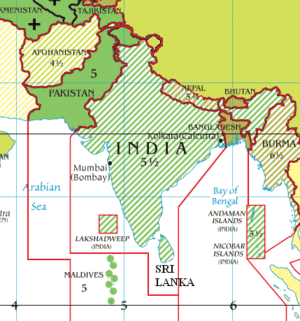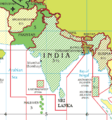Indian Standard Time facts for kids
Quick facts for kids Indian Standard Time |
|
|---|---|

Indian Standard Time
|
|
| UTC offset | |
| IST | UTC+05:30 |
| Current time | |
| 15:38, December 8, 2025 (IST) () | |
| Observance of DST | |
| DST is not observed in this time zone. | |
Indian Standard Time (IST) is the official time zone for India and Sri Lanka. It is 5 hours and 30 minutes ahead of Coordinated Universal Time (UTC+5:30). This means that when it is midnight UTC, it is 5:30 AM in India. Unlike many other countries, India does not use Daylight Saving Time (DST). This means the time in India stays the same all year round.
Contents
What is a Time Zone?
A time zone is a region that uses the same standard time. Imagine the Earth is divided into slices, like an orange. Each slice has its own time. This helps people know what time it is in different parts of the world. It makes travel and communication much easier.
Why Do We Have Time Zones?
The Earth spins around, making the sun appear to move across the sky. When it's noon where you are, the sun is highest in the sky. But at the same moment, it's morning in places to your west and evening in places to your east. Time zones help us keep our clocks in sync with the sun's position. Without them, every city would have its own unique time. That would be very confusing!
How Are Time Zones Decided?
Most time zones are based on lines of longitude. These are imaginary lines that go from the North Pole to the South Pole. The main line is the Prime Meridian, which runs through Greenwich, London. This is where Coordinated Universal Time (UTC) is set. Other time zones are then measured as being a certain number of hours ahead or behind UTC.
Indian Standard Time (IST)
Indian Standard Time is observed across all of India. This means that if you are in Mumbai or Kolkata, your clock will show the same time. This is different from very large countries like the United States or Russia, which have many time zones.
Why Does India Have One Time Zone?
India is a large country, but it uses only one time zone. This was decided to make things simpler for everyone. Having one time zone helps with train schedules, business, and communication across the country. However, some people in the far eastern parts of India feel that the sun rises too early for them.
The History of IST
Before 1905, different cities in India used their own local times. For example, Mumbai (then Bombay) had its own time, and Kolkata (then Calcutta) had another. This caused a lot of confusion. In 1905, the British government, which ruled India at the time, decided to create a single standard time for the whole country. They chose a line of longitude that passes near Allahabad (now Prayagraj) as the central point. This became the basis for Indian Standard Time.
How IST is Calculated
Indian Standard Time is based on the longitude of 82.5° East. This specific line of longitude is 5 hours and 30 minutes ahead of UTC. This half-hour difference is a bit unusual, as most time zones are set in full-hour steps. However, it works well for India's geographical location.
Time Zones Around the World
Time zones help connect the world. When you call a friend in another country, knowing their time zone helps you avoid calling them in the middle of the night! Many countries use Daylight Saving Time to make better use of daylight during summer months. India, however, does not follow this practice.
Impact on Daily Life
Having a single time zone in India means that schools, businesses, and government offices all operate on the same clock. This makes planning and coordination much easier. For example, a train schedule from one end of India to the other uses just one time. This helps everyone stay on schedule.
Images for kids
See also
 In Spanish: Huso horario de la India para niños
In Spanish: Huso horario de la India para niños


